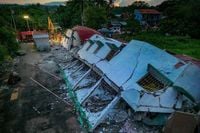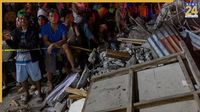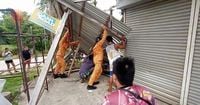Late Saturday night, the southern Philippines was rocked yet again by a magnitude 6.0 earthquake, just one day after a pair of massive temblors had already left the region reeling. According to the United States Geological Survey (USGS), the latest quake struck off the coast near Cagwait town in Surigao del Sur province, at a depth of 59 kilometers. The tremor, which occurred at 8:02 pm local time on October 11, 2025, was felt across communities still recovering from the devastation of the previous day’s seismic events.
For residents of Mindanao, the past 48 hours have been a relentless ordeal. On October 10, two major offshore earthquakes, measuring 7.4 and 6.7 on the Richter scale, struck just hours apart. These powerful tremors killed at least eight people, set off landslides, and forced thousands to flee their homes amid tsunami warnings. The Philippine Institute of Volcanology and Seismology (Phivolcs) confirmed that the quakes originated along the Philippine Trench, a deep underwater fault line to the east of the country, notorious for its seismic volatility.
The initial 7.4-magnitude quake on Friday was particularly harrowing, prompting immediate evacuations in coastal areas. According to AFP, the force of the quake triggered landslides and left streets strewn with debris. Just as residents began to assess the damage, a second strong quake—this one measuring 6.7—hit the same region, compounding the chaos and further escalating fears of a tsunami. Authorities extended tsunami warnings not only across the Philippines but to neighboring Indonesia and Palau as well. The United States National Tsunami Warning Centre predicted waves of 0.3 to 1 meter, cautioning coastal communities to remain on high alert.
In the aftermath, the Philippine Office of Civil Defence reported that at least eight people had lost their lives. Ezzra James Fernandez, Information Officer for the agency, noted, “As to the initial assessment yesterday, the [infrastructure] damage is minimal,” but emphasized that road clearing operations were still underway. By Saturday morning, most roads were already passable, though the psychological and emotional toll on survivors was clear.
Nowhere was this more evident than in Manay, a municipality of 40,000 in Mindanao. On Saturday, residents could be seen removing debris and sweeping up broken glass from homes and shops. With over 800 aftershocks recorded overnight following Friday’s quakes, many survivors spent the night in tents, under tarps and hammocks, inside vehicles, or simply on mats outdoors, too shaken to risk returning to their homes. As one survivor put it, “Nowhere to sleep, nothing to eat,” capturing the sense of despair gripping the community, as reported by South China Morning Post.
Then, just as hope for respite began to flicker, the earth shook again. The magnitude 6.0 quake on Saturday night sent fresh waves of panic through already traumatized towns. Cagwait Fire Officer Arnel Besinga described the moment to AFP: “The duration of the quake was not that long, just around 30 seconds, but it was so sudden and so strong. Our pots here in the fire station fell in our kitchen.” While there were no immediate reports of casualties from this latest quake, Besinga admitted that authorities could not yet assess the full extent of the damage, as it was already dark when the tremor struck. Rescue and fire teams began joint assessments, bracing for the possibility of more bad news come daylight.
It remains unclear whether Saturday’s quake was an aftershock of the twin temblors that struck off Manay town in Davao Oriental province the previous day. Phivolcs chief Teresito Bacolcol confirmed that all three quakes were related to the Philippine Trench fault line, which has a long history of producing powerful seismic events. The agency warned that aftershocks—already numbering more than 800—were likely to persist for weeks, keeping residents on edge and complicating recovery efforts.
The recent series of earthquakes comes on the heels of another tragedy. Just days earlier, on September 30, a magnitude 6.9 quake struck Cebu province in central Philippines, killing 75 people and injuring more than 1,200. The government’s data underscores the vulnerability of the archipelago, which sits atop the Pacific “Ring of Fire”—an arc of intense seismic activity stretching from Japan through Southeast Asia and across the Pacific basin. Earthquakes are, unfortunately, a near-daily occurrence in the Philippines, and the specter of disaster looms large in the national consciousness.
The memory of the country’s deadliest natural disaster still haunts many. In 1976, an 8.0-magnitude quake off Mindanao’s southwest coast unleashed a tsunami that left 8,000 people dead or missing. While advances in early warning systems and disaster response have saved countless lives since then, the events of October 2025 are a stark reminder of the region’s ongoing exposure to nature’s fury.
Despite the initial official assessment of “minimal” infrastructure damage, the human cost is undeniable. In Mindanao, entire communities are coping with loss, uncertainty, and the daunting task of rebuilding. Local authorities and rescue teams continue to clear debris and assess structural damage, prioritizing the restoration of basic services and the safety of residents. Aid organizations have begun to mobilize, providing temporary shelter, food, and medical assistance to those displaced by the quakes.
Meanwhile, the Philippine Institute of Volcanology and Seismology continues to monitor seismic activity closely. With aftershocks expected to persist and the possibility of further major quakes looming, officials urge residents to remain vigilant and prepared. The unpredictability of the Philippine Trench, combined with the region’s dense population and often fragile infrastructure, means that the risk of future disasters is ever-present.
For now, the people of Mindanao and the broader southern Philippines are left to pick up the pieces, drawing on reserves of resilience that have been tested time and again. As Besinga noted, the shock of the latest quake was “so sudden and so strong”—an apt description not only of the tremors themselves but of the challenges facing those determined to rebuild their lives in the aftermath.
The coming weeks will be crucial as authorities, aid groups, and communities work together to recover from one of the most intense periods of seismic activity in recent memory. For many, the hope is simple: that the ground will finally settle, and that the long road to healing can truly begin.


